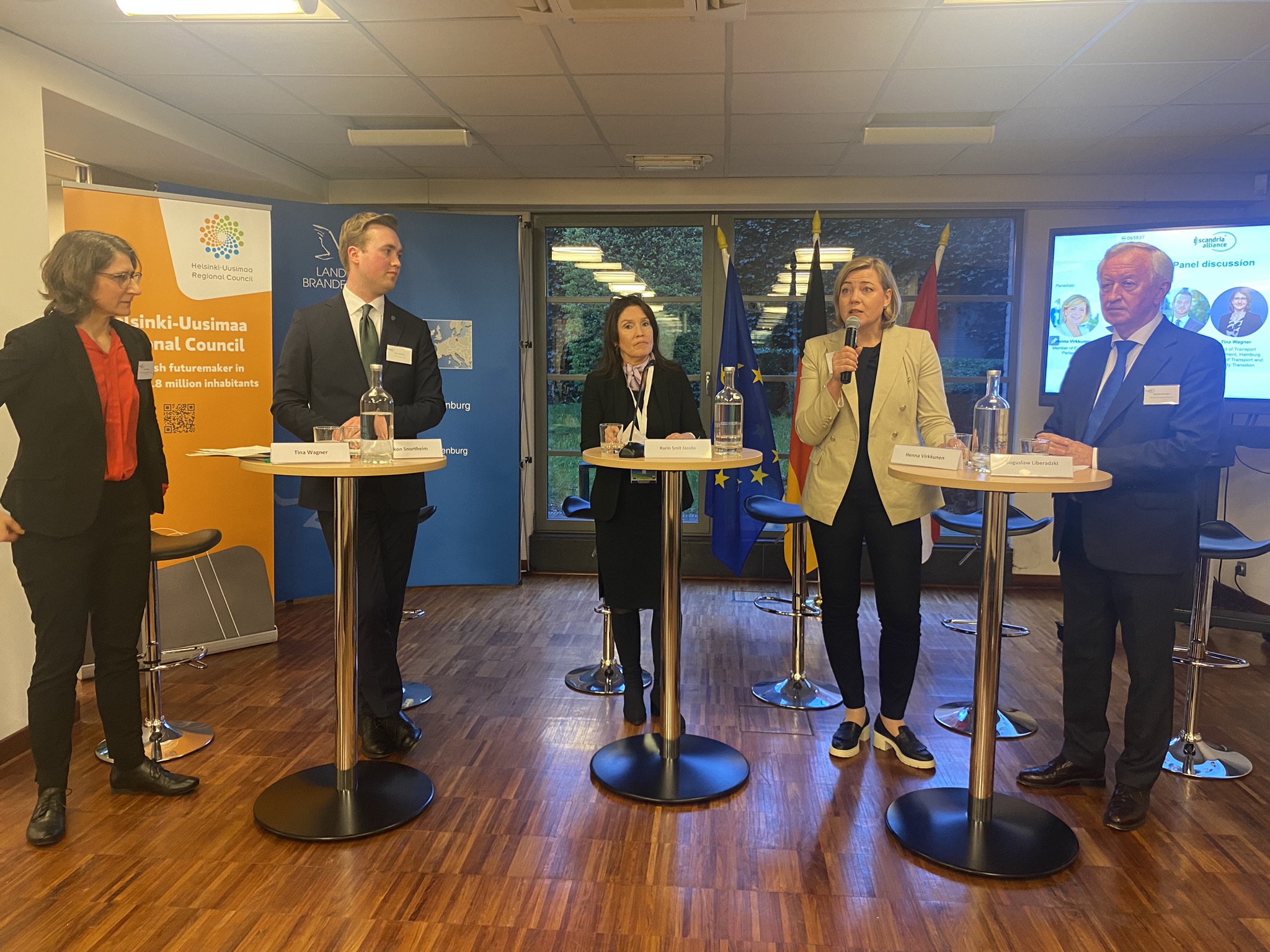Panellists discussed how to resolve the discrepancy between agreed upon goals in greening transport and increasing connectivity on the one hand and tightening public budgets on the other hand.
Rainer Genilke, Brandenburgian Minister of Infrastructure and Federal State Planning, and Tuija Telén, Regional Mayor of Helsinki-Uusimaa Region, as chair and vice chair of the Scandria®Alliance, had extended the invitation to a high-level Scandria®Alliance evening event at Brandenburg’s representation to the EU on 3 April 2024 on the occasion of the 2024 Connecting Europe Days.
After more than two years of negotiations, the revised TEN-T regulation is expected to enter into force in May 2024. The revision has focused largely on reducing emissions in the transport sector, as well as increasing connectivity between Northern and Southern as well as Western and Eastern Europe. According to a joint position paper released by the TEN-T Coordinators during the Connecting Europe Days, the investment needs to realize the TEN-T amount to € 845 bn in the course of the next fifteen years. This amount does not include maintenance costs and the costs arising from increasing climate risks and climate change impacts on transport infrastructure. Simultaneously, Europe is going through an economic downturn as a result of increased international tensions, fuelled largely by the Russian aggression against Ukraine.
In our panel discussion, high-level representatives of the European and regional level discussed ways to resolve the discrepancy between agreed upon goals in greening the transport sector and increasing connectivity on the one hand, and the tightening financial resources on the other hand.
The European level was represented by the Members of European Parliament Henna Virkkunen (EPP, Finland) and Bogusław Liberadzki (S&D, Poland).
Scandria®Alliance member cities and regions were represented by Tuija Telén, Regional Mayor of Helsinki-Uusimaa Region (Finland), Anne Strømøy, County Mayor of Vestfold County (Norway), Tina Wagner, Head of Transport Department, Hamburg Ministry of Transport and Mobility Transition (Germany) and Håkon Snortheim, Councillor for Transport, Akershus County (Norway) during the event.
The panel discussion was moderated by Karin Smit Jacobs, Director for EU Transport and Energy at the Conference of Peripheral Maritime Regions (CPMR).
What the new EU institutions should focus on
According to the interventions of MEPs Virkkunen and Liberadzki, the European Union should invest much more in our infrastructure and our connections during the coming years. The strategic competitiveness of the European Union, security resilience and preparedness as well as the green transition are pivotal for the European Transport Sector.
Because of its competitive advantage for long-haul transportation of freight in terms of lower emissions and higher energy and spatial efficiency, a particular focus needs to be placed on rail and common European methodologies and standards for railways.
In order to achieve set sustainability goals and become climate neutral by 2050, a better and more effective use of funding and performance reviews is also crucial, according to MEP Liberadzki.
According to the interventions of the Scandria®Alliance members, the Connecting Europe Facility (CEF) has proven to be of key importance for realizing the TEN-T and bringing an added European value to transport infrastructure investments. Therefore, the Scandria®Alliance members call on decision-makers on the European and national levels to work vigorously towards a continuation and strengthening of the CEF beyond 2027. At the same time, also alternative funding mechanisms need to be developed both at the European and national levels. To build a greener, more efficient and resilient transport network, which ensures connectivity without bottlenecks or missing links, TEN-T has to focus on cross-border links and connections including their hinterland connections, as well as urban nodes.
How cities and regions can contribute
Our members’ representatives underlined the key role that cities and regions play in implementing the TEN-T and other European transport policies. In the revised TEN-T regulation, this has been acknowledged by reinforcing the role of urban nodes, which are of crucial importance both for a functional transport network as well as the European Union’s economic competitiveness and innovative potential.
On the local and regional level, urban nodes and their functional urban areas are at the forefront of implementing the necessary shift towards sustainable and innovative modes of transport. To name two examples: Helsinki claims the top rank in the recent Urban Mobility Readiness Index of the Oliver Wyman Forum and Hamburg has the ambitious aim of making a public transport offer available to each citizen within the reach of 5 minutes.
On the corridor level, cities and regions also play an active role in removing bottlenecks on the transport corridors and pro-actively working towards improved cross-border connections. The work that Hamburg is doing to strengthen and renew the infrastructure of the Hamburg railway node and to improve the railway hinterland connections of its port as well as the strong commitment of Eastern Norwegian regions for improved cross-border connections on the stretches Oslo-Gothenburg, Oslo-Stockholm and the Jutland corridor are a few examples that our members’ representatives mentioned in this context.
TEN-T policy is an important driver for urban and regional development and the local and regional level is actively involved in building a sustainable, smart and resilient TEN-T. Therefore, cities and regions need to be adequately involved in the TEN-T Corridor governance in line with principles of multi-level governance and subsidiarity. With a view to the increased number and reinforced role of urban nodes, collaboration platforms such as the Scandria®Alliance or the Interregional Alliance for the Rhine-Alpine Corridor EGTC can act as interfaces between the urban nodes and the corridor coordinators. To become an even stronger voice, the Scandria®Alliance extended a warm invitation to further corridor regions to join the cooperation of cities and regions along the ScanMed corridor.
